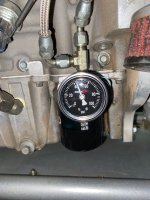As LRS said you should use a mechanical gauge and measure at the Oil filter adapter near the pan this is directly on the main oil rail and will be the most accurate as to what the mains see.
You can also test at the plug near the front of the engine (where a lower alternator would be) this will show you direct pump output ...
But unfortunately I think you are going to find the numbers are pretty close to what you are seeing on the electric gauge when the engine is warm.
LS's in general have oiling issues - the OIL pump runs off the crank and turns the speed of the crank and therefore unlike many other engines that turn off the CAM its hard to get a oum that is efficient at low rpm and does not cavitate at high RPM - they also have the limitation that if you use a High pressure spring in the pump it just changes the pressure the pump bypasses rather than regulates the pressure across the RPM rabge like a small block chevy or other engines. So changing the spring does nt give you more pressure at idle.
Its also true that the Pickup design is not ideal - as mentioned above it uses an O-ring and suck air if the O-ring is bad - but they hardly go bad - that problem usually happens after a rebuild because the wrong o0ring is put in (there are 4 colors and it confusing). Or Very high mileage engines the oring can split - but thats Very unusual.
More commonly the engines just have bad clearances - most commonly casued by someone putting a clutch on an engine that was an automatic and center thrust bearing now has more ckearance - sometimes you can even see this by Pushing in the clutch at idle and watching the OP drop by 3-5 or more lbs.
Using a heavier oil can band aid the problem and hide a clearance issue - MAYBE - I have seen it work sometimes and not many times .
Its also common for LS's to overheat the oil and they thin out - thats an easy test - if you change the oil ad the pressure is good for the first few hours the problem is heat
The oil pumps also wear an they get sloppy, so changing to a new better pump (a blueprinted pump is the best way to go -( JALPER does those here on GD) the pump usually helps a little (assuming you get the right o-ring ...) and going to a high volume pump - always brings the pressure up 10-20lbs - BUT you have to be really careful to keep the Oil always full because you can suck a 5 quart pan dry on extending High rpm runs.
The Hi Vol pump is not really a band aid as the bearing usually don't get hammered out in 10-20K miles after the pressure drops, but its ALWAYS an indicator something is going wrong. A Hi pressure pump is fine as well because it will increase the pressure at higher RPM but again be careful sucking the pan dry - Do that 2 or 3 times and you will wioe the bearings ...
When I have changed to a Hi Vol Pump with an F body or 5 quart pan I always Install an Oil cooler it privides an extra couple quarts in the system and I never saw a problem after that ... it also cools the oil which stops it thinning out
One more thing - Most engines NEED 10Lbs mimimal at Idle 10 Lbs per 1000 RPM to be safe - the LS really needs 15 at hot idle and 50Lbs is fine up to 7500RM
People constantly chase LS oil pressure issues (I have too) and its really stressful and often not a great outcome if you let it go FWIW


